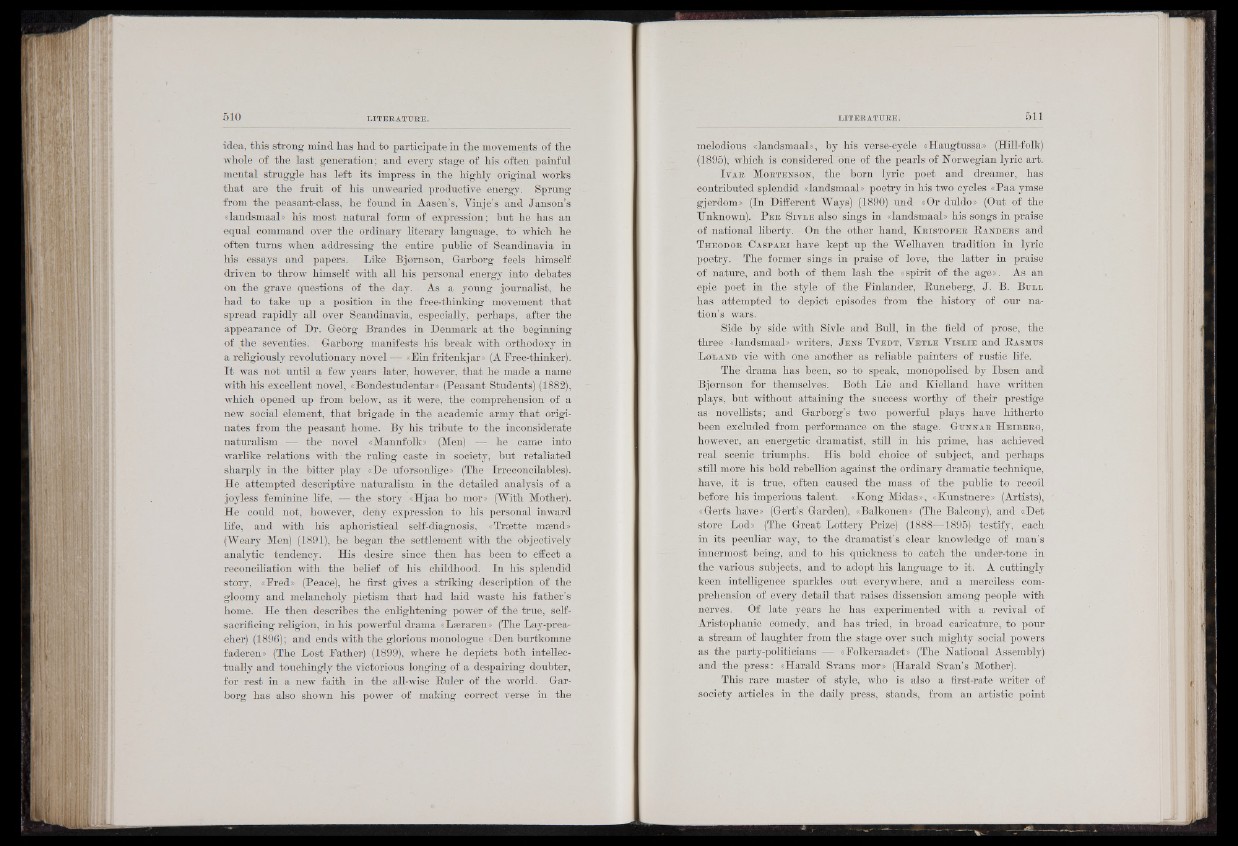
idea, this strong mind has had to participate in the movements of the
whole of the last generation; and every stage of his often painful
mental struggle has left its impress in the highly original works
that are the frnit of his unwearied productive energy. Sprung
from the peasant-class, he found in Aasen’s, Yinje’s and Janson’s
«landsmaal» his most natural form of expression; but he has an
equal command over the ordinary literary language, to which he
often turns when addressing the entire public of Scandinavia in
his essays and papers. Like Bjornson, Garborg feels himself
driven to throw himself with all his personal energy into debates
on the grave questions of the day. As a young journalist, he
had to take up a position in the free-thinking movement that
spread rapidly all over Scandinavia, especially, perhaps, after the
appearance of Dr. Georg Brandes in Denmark at the beginning
of the seventies. Garborg manifests his break with orthodoxy in
a religiously revolutionary noyel BfjsEin fritenkjar» (A Free-thinker).
I t was not until a few years later, however, that he made a name
with his excellent novel, «Bondestudentar» (Peasant Students) (1882),
which opened up from below, as it were, the comprehension of a
new social element, that brigade in the academic army that originates
from the peasant home. By his tribute to the inconsiderate
naturalism --H- the novel «Mannfolk» (Men) he came into
warlike relations with • the ruling caste in society, but retaliated
sharply in the bitter play «De uforsonlige» (The Irreconcilables).
He attempted descriptive naturalism in the detailed analysis of a
joyless feminine life, — the story «Hjaa ho mor» (With Mother).
He could not, however, deny expression to his personal inward
life, and with his aphoristical self-diag'nosis, «Trætte mænd»
(Weary Men) (1891), he began the settlement with the objectively
analytic tendency. His desire since then has been to effect a
reconciliation with the belief of his childhood. In his splendid
story, «Fred» (Peace), he first gives a striking description of the
gloomy and melancholy pietism that had laid waste his father’s
home. He then describes the enlightening power of the true, self-
sacrificing religion, in his powerful drama «Læraren» (The Lay-prea-
cher) (1896); and ends with the glorious monologue «Den burtkomne
faderen» (The Lost Father) (1899), where he depicts both intellectually
and touchingly the victorious longing of a despairing doubter,
for rest in a new faith in the all-wise Buler of the world. Garborg
has also shown his power of making correct verse in the
melodious «landsmaal», by his verse-cycle «Haugtussa»., (Hill-folk).
(1895), which is considered one of the pearls of Norwegian lyric art.
I v a r M o r t e n s o n , the bom lyric poet and dreamer, has
contributed splendid «landsmaal» poetry in his two cycles «Paa ymse
gjerdom» (In Different Ways) (1890) und «Or duldoi]i(Out of the
Unknown). P e r S iv l e also sings in «landsmaal» his songs in praise
of national liberty. On the other hand, K r i s t o e e r B a n d e r s and
T h e o d o r C a s p a r i have kept up the Welhaven tradition in lyric
poetry. The former sings in praise of love, the latter in praise
of nature, and both of them lash the «spirit of the age». As an
epic poet in the style of the Finlander, Buneberg, J . B. B u l l
has attempted to depict episodes from the history of our nation’s
wars.
Side by side with Sivle and Bull, in the field of prose, the
three «landsmaal» writers, J e n s T v e d t , Y e t l e Y i s l i e and B a s m u s
L o l a n d vie with one another as reliable painters of rustic life.
The drama has been, so to speak, monopolised by Ibsen and
Bjornson for themselves. Both Lie and Kielland have written
plays, but without attaining the success worthy of their prestige
as novellists; and Garborg’s two powerful plays have hitherto
been excluded from performance on the stage. G u n n a r H e i b e r g ,
however, an energetic dramatist, still in his prime, has achieved
real scenic triumphs. His bold choice of subject, and perhaps
still more his bold rebellion against the ordinary dramatic technique,
have, it is tiue, often caused the mass of the public to recoil
before his imperious talent. «Kong Midas», «Kunstnere» (Artists),
«Gerts have» (Gert’s Garden), «Balkonen» (The Balcony), and «Det
store Lod» (The Great Lottery Prize) (1888l|fl895) testify, each
in its peculiar way, to the dramatist’s clear knowledge of man’s
innermost being, and to his quickness to catch the under-tone in
the various subjects, and to adopt his language to it. A cuttingly
keen intelligence sparkles out everywhere, and a merciless' comprehension
of every detail that raises dissension among people with
nerves. Of late years he has experimented with a revival of
Aristophanic comedy, and has tried, in broad caricature, to pour
a stream of laughter from the stage over such mighty social powers
as the party-politicians — «Folkeraadet» (The National Assembly)
and the, press: «Harald Svans mor» (Harald Svan’s Mother).
This rare master of style, who is also a first-rate writer of
society articles in the daily press, stands, from an artistic point